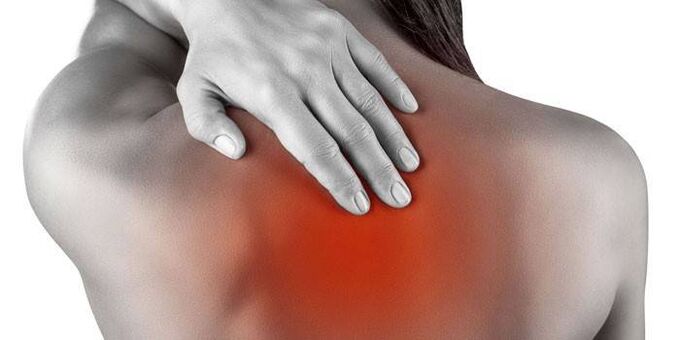The most common problem of the spine is osteochondrosis. The disease can affect all parts of the spine, which is subject to increased stress. It manifests itself at any age, more often the older generation is at risk. Symptoms of osteochondrosis of the thoracic spine increase with an acute attack of pain.
What is osteochondrosis of the thoracic spine in women
This disease is characterized by dystrophic and degenerative disorders of the spinal cord, changes in the structure and shape of the intervertebral discs. Osteochondrosis of the spine progresses to the age of 40 and many patients carry it on their feet. It is impossible to do this because over time the intercostal nerves stretch; Disability is not ruled out. The upper chest vertebrae are involved in the pathological process and the patient is diagnosed with the disease with characteristic chest pain.
Symptoms of breast osteochondrosis in women
It is problematic to diagnose the disease of the fairer sex, since its symptoms are similar to the manifestations of other pathological conditions of the female body. For example, a severe attack of pain in the peritoneal region may be the cause of breast damage, or it may be the result of a heart attack, angina pectoris. You need to take a heart medication to refute or confirm your assumption. The lack of positive dynamics indicates that the heart is healthy and obvious problems with the spine predominate.
Some patients believe that the cause of the pain is chronic gastritis or duodenal ulcer. In fact, these are the hallmarks of breast osteochondrosis in women, which only increase over time, becoming more intense, long-lasting. The diagnosis can be confused with shingles because the pain can be localized to the same area. In order to properly differentiate the disease, the characteristics of some symptoms are not sufficient; An integrated approach to the progressive problem is needed.

Symptoms of chest osteochondrosis in men
The disease can develop in the body of men, especially if you follow a sedentary lifestyle, choose yourself hard physical work. Signs of chest osteochondrosis can be confused with acute pleurisy, angina pectoris, scoliosis, cholecystitis, and other myocardial pathologies. You can be sure that this is not a heart attack with medication, but only the attending physician will prescribe heart pills. Superficial self-medication is completely ruled out. This disease causes not only chest pain but also other symptoms:
- Numbness of the legs;
- Crawling on the skin;
- Increased muscle tension;
- Symptoms of impaired potency;
- Lumbago in the middle capillary region.
How is chest osteochondrosis manifested?
The disease begins with an acute attack of pain that is localized in the chest, resembling a heart attack. Initially, painful sensations are observed during tilting, sharp tilting of the body, and deep breathing. Over time, dorsalgia recalls itself at rest as well. Since the focus of the pathology is localized in the upper part of the chest, due to the lack of adequate treatment, complications are observed in relation to the myocardium, affecting the cardiovascular system. In addition, chest osteochondrosis is manifested by the following neurological symptoms:
- Creeping legs;
- Reflex tension of the back and chest muscles;
- Dysfunction of the pelvic organs;
- Numbness of the abdomen and upper bump;
- Pain that will worsen during moderate exercise.
How does chest osteochondrosis hurt?
Not all patients know what chest osteochondrosis looks like - the symptoms do not manifest themselves for some time. The localization of the lesion can be determined clinically, but the patient should first consult a specialist with complaints of back pain or lumbar disc herniation. If they are not treated in time, the symptoms of the characteristic disease only increase, intensify. Chest pain in osteochondrosis has a different nature, it depends on the degree of the pathological process and the specifics of the organism.

Exacerbation of thoracic osteochondrosis
If the trunk has been sitting for a long time, in the course of progressive osteochondrosis, the case of Dorsago is not excluded. It is an acute attack of pain that can radiate to the cervix and lumbar spine while disrupting breathing, paralyzing the clinical patient movements. Exacerbation of thoracic osteochondrosis simply begins with sharp attacks on the left and right sides of the bone that are difficult to stop with medication. It is impossible to simulate such a condition, as it disturbs the patient in bed, deprives him of sleep and rest.
If we talk about the growing symptoms of dorsalgia, then this sign of chest osteochondrosis develops later. It appears in the hypochondrium, but before that it develops unnoticed for 2-3 weeks. Extensive damage to the intercostal spaces begins with a feeling of general discomfort when changing the trunk position, which is subsequently replaced by a dangerous attack of pain in the ridge region. Among the complications, doctors distinguish inflammation of the gallbladder and spine.
Attacks of osteochondrosis of the chest region
In such an unpleasant disease the nerve fibers suffer, so the attack is always accompanied by severe pain, which has an unexplained localization in the early stages of development. Initially, the unpleasant sensations are marked by sudden movements, in case of increased activity, coughing and sneezing, but then specific symptoms manifest themselves even at night, when the body is relaxed and at rest.
Frequent attacks of pectalgia are not excluded, when the acute pain is concentrated in the anterior part of the chest, does not allow inhalation and exhalation, literally paralyzes the whole body, disrupts the usual rhythm of life. In the absence of timely therapy, such painful attacks of osteochondrosis of the chest region only increase, making a healthy person void.

Symptoms of advanced osteochondrosis
The disease to an advanced degree causes the intervertebral discs to move, disrupting the shape and structure of the spinal column. For the patient it is a sharp pain that does not allow the body to rotate, restrict movement and physical exertion, which is one of the main causes of unstable emotional sphere. During the pathological process, the systemic circulation is disturbed and the progressive symptoms of advanced osteochondrosis lead to such health complications:
- Cardiac muscle dystrophy;
- Renal dysfunction;
- Intervertebral hernia;
- Symptoms of impaired potency;
- shingles;
- Dystrophy of other parts of the spine;
- Extensive damage to internal organs.

















































